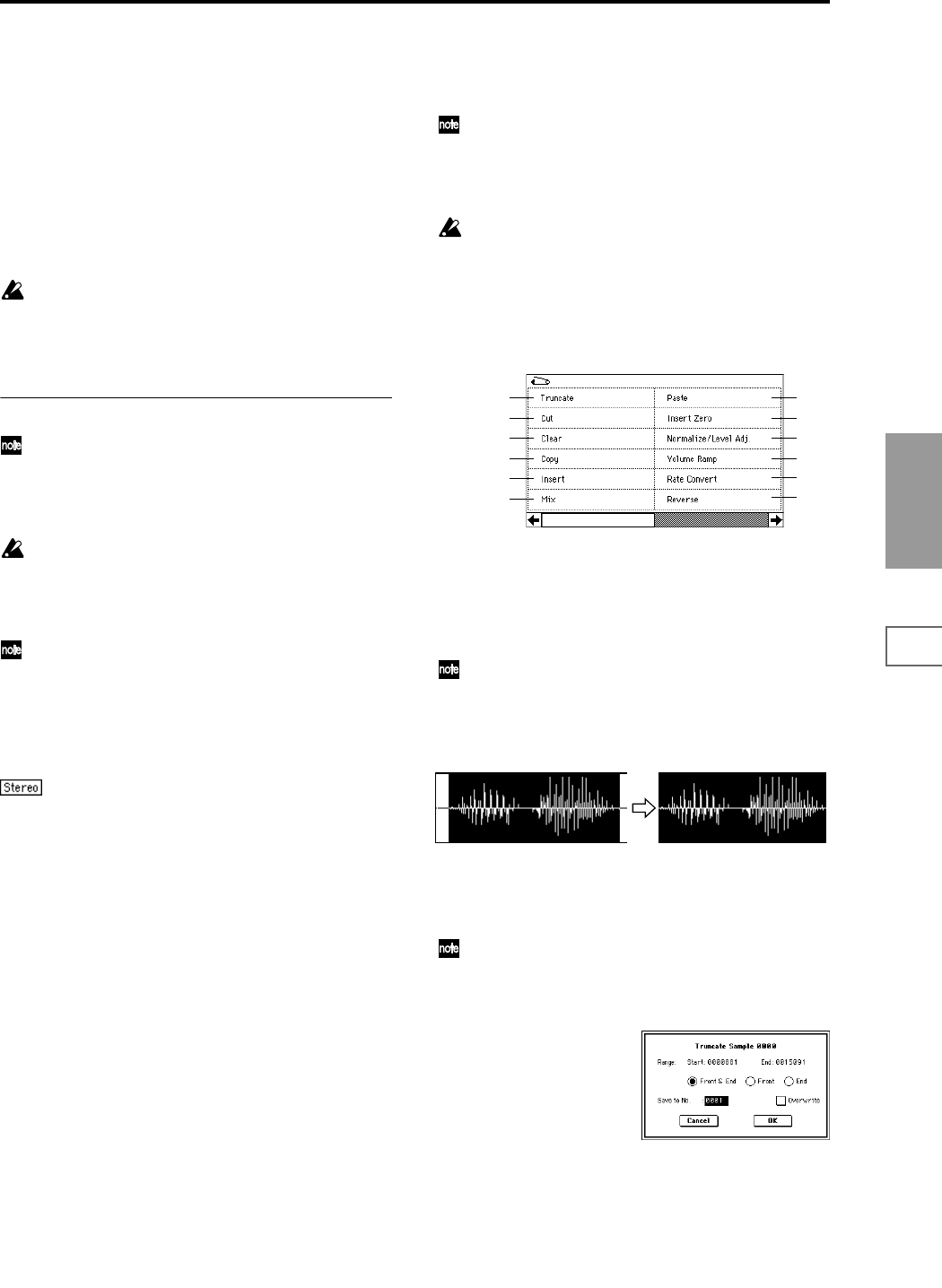
101
Sampling
P0
P1 P2 P3 P4 P5 P8
For example if you change the sample address by one, the
vertical line in the LCD that indicates the sample address
will move in steps of one pixel.) In the vertical axis, you can
zoom-in from 1X (full range display) to 512X (or 1024X in
the case of stereo display).
Zoom-In/zoom-out will occur starting at the “Edit Range
Start” or “Edit Range End” points you specify. (If a different
parameter is selected when you zoom-in or -out, the zoom-
in/out will be based on the last-selected point. If you re-
select the “Edit Range Start” or “Edit Range End” points
when the display is zoomed in or out, the display range will
be adjusted so as to show the selected point.)
If the zoom ratio is low (1X or less), the “sample wave-
form display” may differ slightly from the displayed
waveform before and after waveform editing, but this
does not affect the playback sound. If this occurs, rais-
ing the zoom ratio will make the display accurate.
▼ 1–1: Page Menu Command
When using the page menu commands “Truncate”–
“Volume Ramp” to edit the waveform data of a sample,
first use “Edit Range Start” and “Edit Range End” to
select the range that will be edited, and then choose and
execute the desired page menu command.
There is no compare function that lets you return the
edited result to the state before editing. If you wish to
preserve the unedited sample, uncheck the “Over-
write”
*1
item in the dialog box of each page menu com-
mand before you execute.
To edit the “Start” (start address) location at which the
sample data (waveform data) will begin playing, the
“LoopS” (loop start address), or “End” (end address),
use P2: Loop Edit. If the above parameters are located
within an area of sample addresses that are deleted or
moved by your editing, they will automatically be
moved.
Remarks on editing stereo samples
• For stereo samples, the L channel and R channel samples
are edited simultaneously. If you wish to edit only the L
channel or R channel, select a mono multisample, and
select either the L channel or R channel sample for
editing.
• For stereo samples, the display will indicate “Save to
No.(L)” and “(R).” These respectively specify the
writing-destination sample numbers for the L and R
channels.
• If you “Copy” a mono sample into the buffer, and then
“Insert,” “Mix,” or “Paste” it to a stereo sample, the data
will be inserted, mixed, or pasted into both the L and R
sides. (The result is that a stereo sample will be created.)
If you “Copy” a stereo sample into the buffer, and then
“Insert,” “Mix,” or “Paste” it to a mono sample, the L-
and R-side data in the buffer will be mixed to mono, and
then inserted, mixed, or pasted. (The result is that a mono
sample will be created.)
You can also use these commands if you wish to mono-
mix a stereo sample and use it as a mono sample. How-
ever, be aware that once a sample has been mixed to
mono, it is no longer possible to return it to a stereo sam-
ple.
*1
: About “Overwrite”
When “Overwrite” is unchecked: When the command is
executed, the edited sample will be saved in a different sam-
ple number. The unedited sample will remain without
change.
When “Overwrite” is checked: When the command is exe-
cuted, the edited sample will be overwritten onto the origi-
nal sample (number). The original sample will be modified.
Normally, you will leave “Save to No.” at its default
setting, and execute without checking “Overwrite.”
When you execute, both the data before and after edit-
ing will be preserved, and the sample number of the
edited data will be assigned as the sample of that index.
Loop Start Address “LoopS” and End Address “End”
(2–1c) must be located at least eight addresses apart. If
as a result of executing “Truncate” (1–1A), “Cut” (1–
1B), or “Rate Convert” (1–1K), the Loop Start Address
and End Address would be separated by less than eight
addresses, the display will indicate “Sample length is
shorter than minimum.” Please set the “Edit Range
Start” and “Edit Range End” appropriately.
1–1A: Truncate
This command deletes unwanted data that lies beyond the
“Edit Range Start” and “Edit Range End.” Use this com-
mand when you wish to delete silence at the beginning or
end of the waveform data.
If you wish to delete unneeded (unplayed) sample data
after setting the Start Address “Start,” Loop Start
Address “LoopS” and End Address “End” (2–1c), use
the “Truncate” page menu command found in P2: Loop
Edit.
1 Use “Sample Select” (1–1b) to select the sample that you
wish to edit, and use “Edit Range Start” and “Edit Range
End” to specify the editing range.
You can press the SAMPLING [START/STOP] key to
hear the portion that will be left by the “Truncate” com-
mand.
2 Select “Truncate” to access the dialog box.
3 The editing range will be shown in Range “Start” and
“End.”
4 Use the radio buttons to select the portion that will be
deleted.
Front & End: The sample data that lies before the “Edit
Range Start” and after the “Edit Range End” will be
deleted.
Front: The sample data that lies before the “Edit Range
Start” will be deleted.
1–1A
1–1B
1–1C
1–1D
1–1E
1–1G
1–1H
1–1I
1–1J
1–1F
1–1K
1–1L
